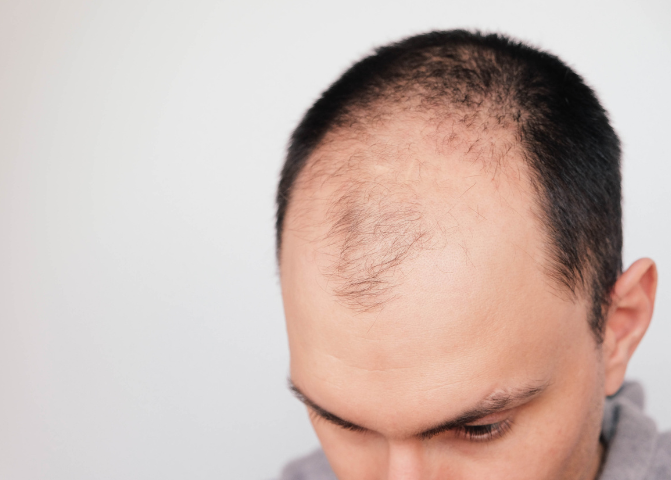30/10/2023
Hair Loss: A Guide To Causes And Treatments
Table of Contents
Our hair has a way of making us feel confident, attractive, and in many cases, uniquely ourselves. But for millions of individuals around the world, the hair loss cause is due to a common yet often misunderstood condition known as androgenic alopecia.
Androgenic alopecia, more commonly referred to as male-pattern baldness or female-pattern baldness, transcends gender, affecting both men and women. It’s not just a matter of vanity; it’s an issue that can profoundly impact self-esteem, self-image, and quality of life.
In our guide, we embark on a journey to unlock the secrets of androgenic alopecia, demystifying its causes, patterns, and treatment options. We’ll explore the science behind this condition, its hereditary nature, and the pivotal role that hormones play in dictating our locks’ destiny.
But this isn’t merely an exploration of the science. It’s a guide to understanding and coping with the emotional and psychological aspects of hair loss. We’ll delve into the importance of self-acceptance, the courage to seek treatment, and the transformative power of knowledge.
Whether you’re someone dealing with the early signs of hair loss, a concerned friend or family member, or simply curious about this prevalent condition, our guide aims to provide insights, advice, and, most importantly, a sense of community. Together, we’ll navigate the world of androgenic alopecia, helping you embark on a journey to a fuller understanding of this condition and the path to embracing your unique beauty, with or without a full head of hair.
Let’s delve into the underlying causes of hair loss and explore the available treatment options.
Understanding the Hair Growth Cycle
To comprehend hair loss, it’s essential to grasp the intricacies of the hair growth cycle, which comprises three key phases:
Anagen (Active Growth)
This is the phase when hair is actively growing and represents the majority of scalp follicles, accounting for approximately 85-90%. During this phase, hair typically grows at a rate of about 1 centimeter per month. Anagen can last for 2 to 6 years before transitioning to the next stage.
Catagen (Transition)
In this transitional phase, hair growth slows as the follicle prepares for the resting phase, known as telogen. Only about 1% of follicles are in the catagen stage at any given time, lasting around 1-2 weeks.
Telogen (Resting or Shedding)
The final stage involves approximately 10-15% of follicles, which remain in a resting state for roughly 20 weeks. It’s normal to shed up to 100 hairs daily during the telogen phase, often noticed while brushing or washing, which is considered part of the natural shedding process.
What is Alopecia?
Androgenic alopecia, also known as male-pattern baldness or female-pattern baldness, is the most common cause of hair loss in both men and women. It’s a hereditary condition that results in the gradual thinning of hair and the eventual loss of hair in a well-defined pattern.
In men, androgenic alopecia typically presents as a receding hairline, which often starts with a receding at the temples and then progresses to baldness on the crown (vertex) of the head. In women, it usually leads to generalized thinning, especially along the part line, and a reduction in overall hair volume.
The term “androgenic” is used because the condition is linked to androgens, which are male sex hormones. In particular, a hormone called dihydrotestosterone (DHT) plays a significant role in androgenic alopecia. DHT is derived from testosterone and, in individuals with a genetic predisposition to the condition, it can lead to the miniaturization of hair follicles. Over time, affected hair follicles produce thinner and shorter hairs, which eventually stop growing altogether.
Androgenic alopecia is a progressive condition, and its severity can vary from person to person. It can be hereditary. And if your parents or grandparents had this hair loss, you might be more susceptible. While there’s no cure for androgenic alopecia, treatments can slow down hair loss and sometimes encourage regrowth. In comparison, hair transplant procedures offer a more lasting solution to restore hair in affected areas.

What Triggers Hair Loss?
Hair loss, often referred to as androgenic alopecia, is a condition influenced by a combination of genetic predisposition and hormonal changes. These changes result in a shortened anagen (growth) cycle, leading to the replacement of normal hairs with shorter and finer ones. Over time, these hairs continue to thin until the affected follicles cease functioning and eventually wither away. In men, it begins with a receding hairline on the temples and progresses to baldness on the scalp vertex. In women, it initially manifests as generalized thinning, resulting in a wider part line and decreased overall volume.
Is there a Cure for Hair Loss?
Regrettably, there’s no outright cure for hair loss. However, several treatments are available that can significantly slow down and even reverse the process.
Consult an Online Doctor at Medmate Today!
At Medmate, our doctors can provide advice about hair loss treatments. Make an appointment today to explore your individualized treatment options and take the first step towards healthier, fuller hair.
Recommended reading
Search for a specific topic or filter by categories to find information on what you need to know on the full Medmate Journal


The Belt Squat RDL is a Game-Changer
Looking to build a stronger, more powerful lower body while minimizing risk? The Belt Squat RDL might just be the exercise you’ve been missing. This unique movement, often overlooked, offers…
